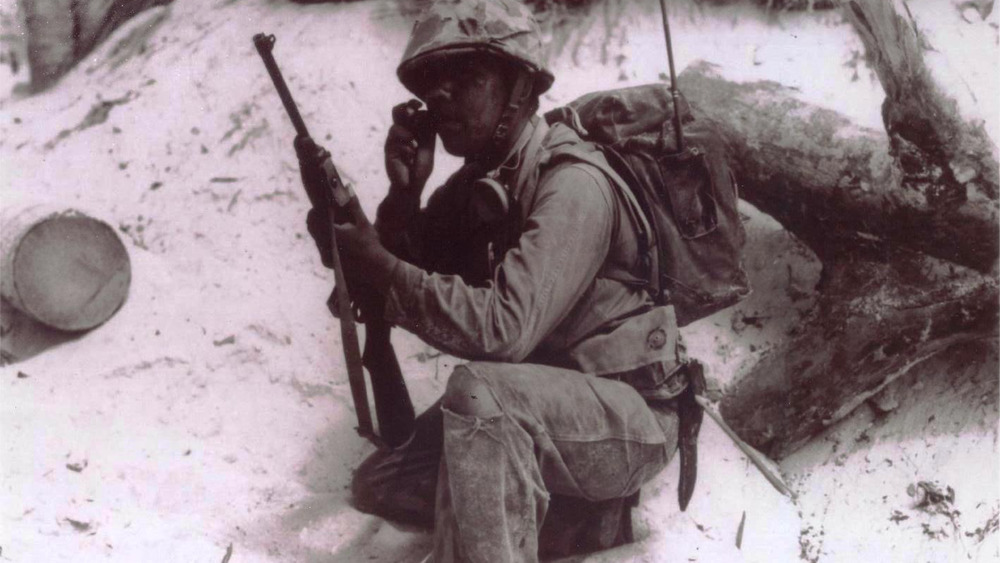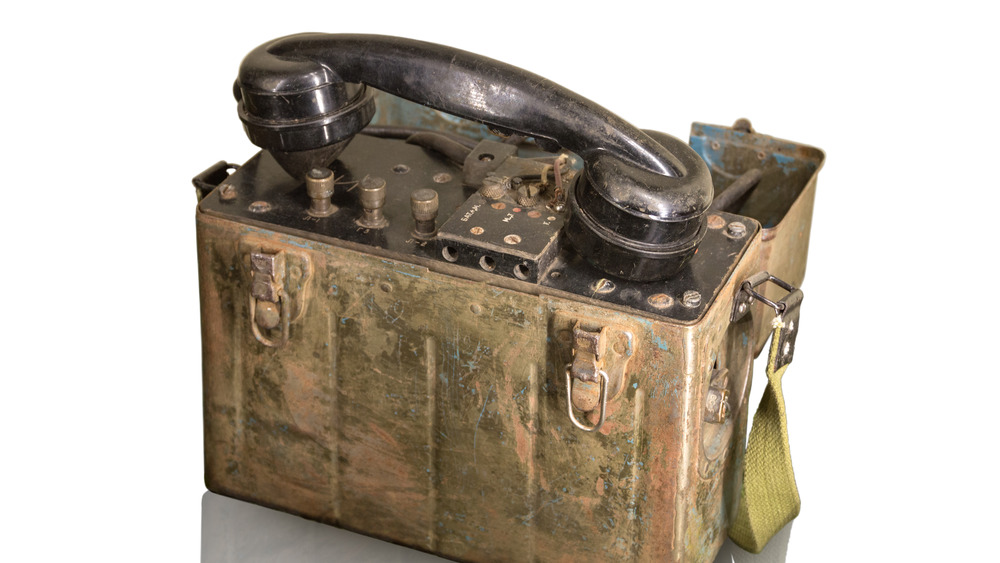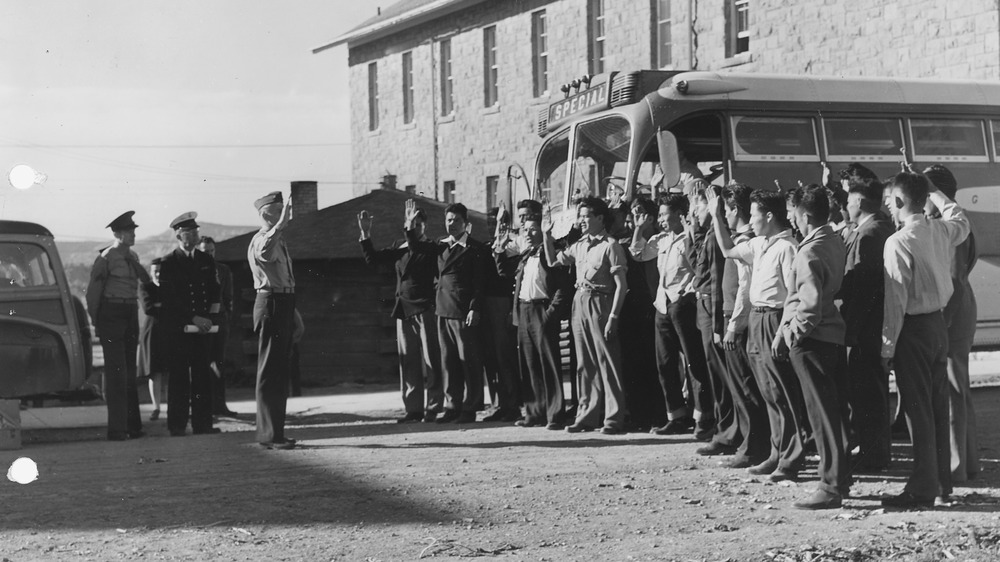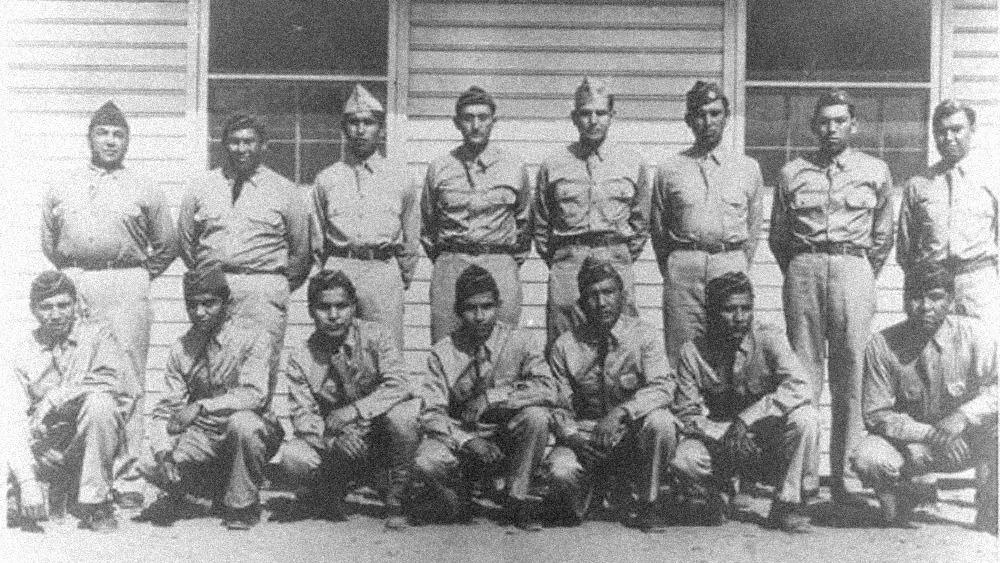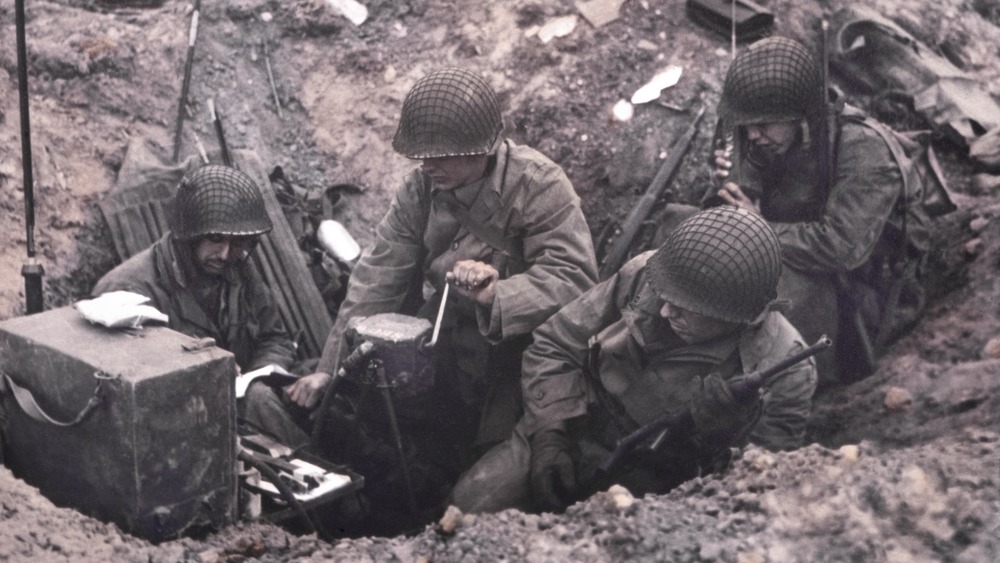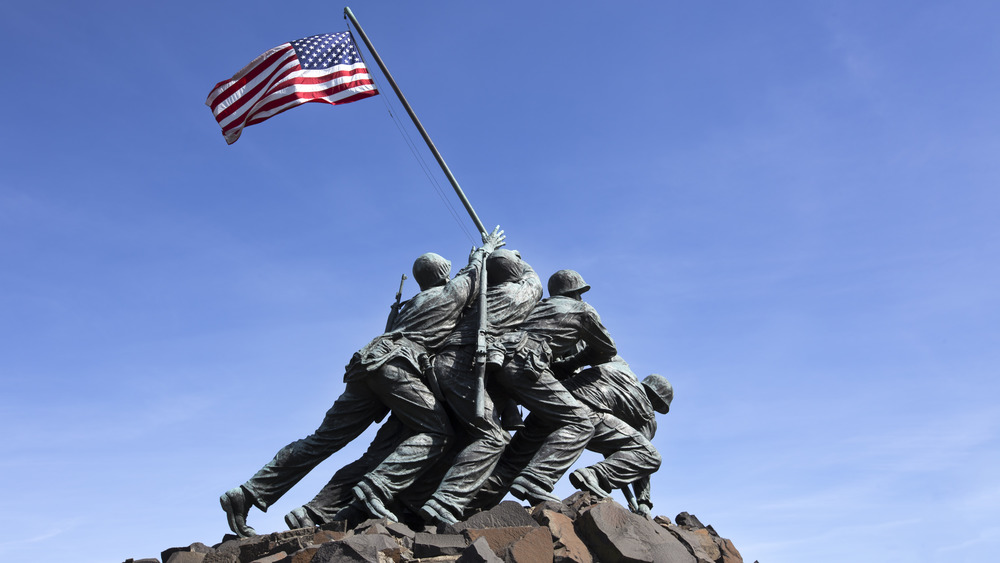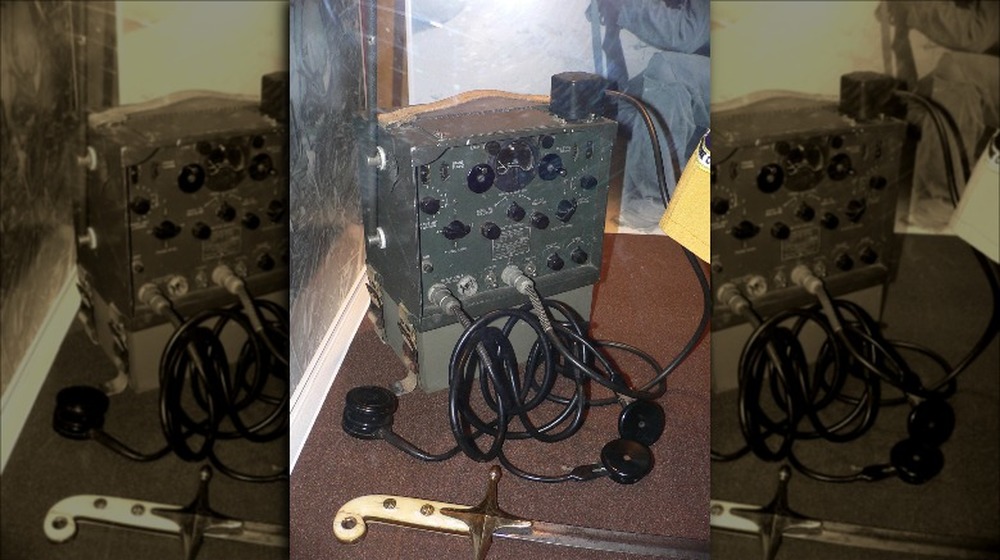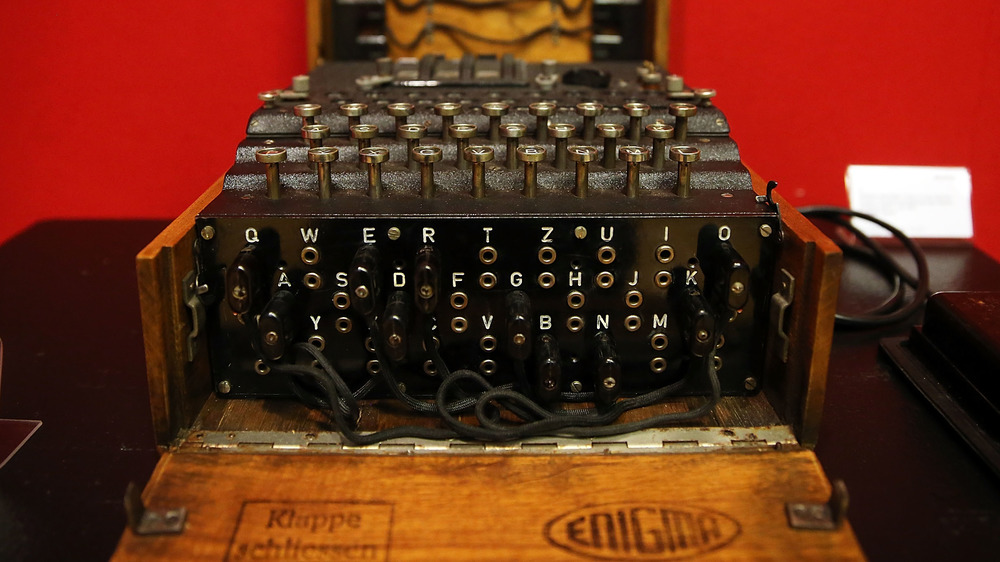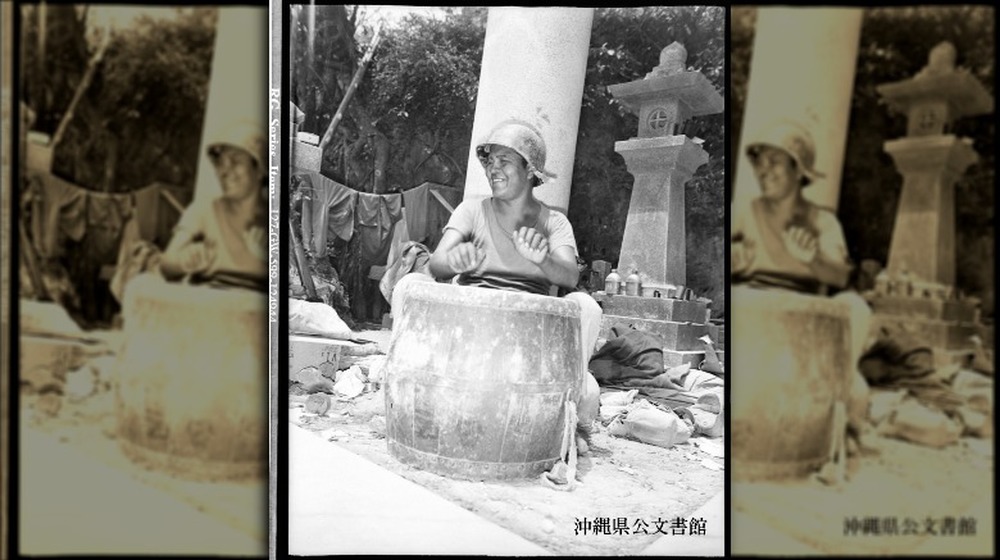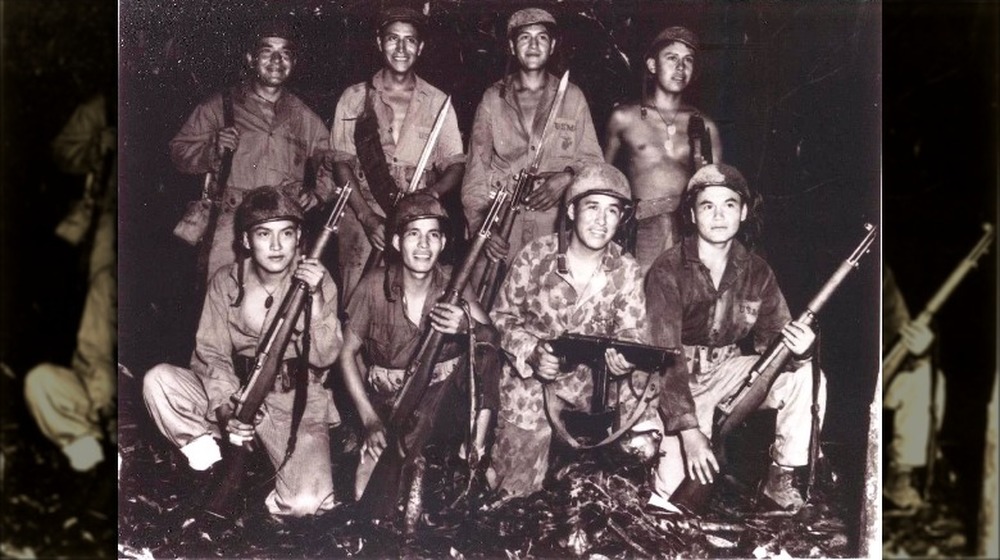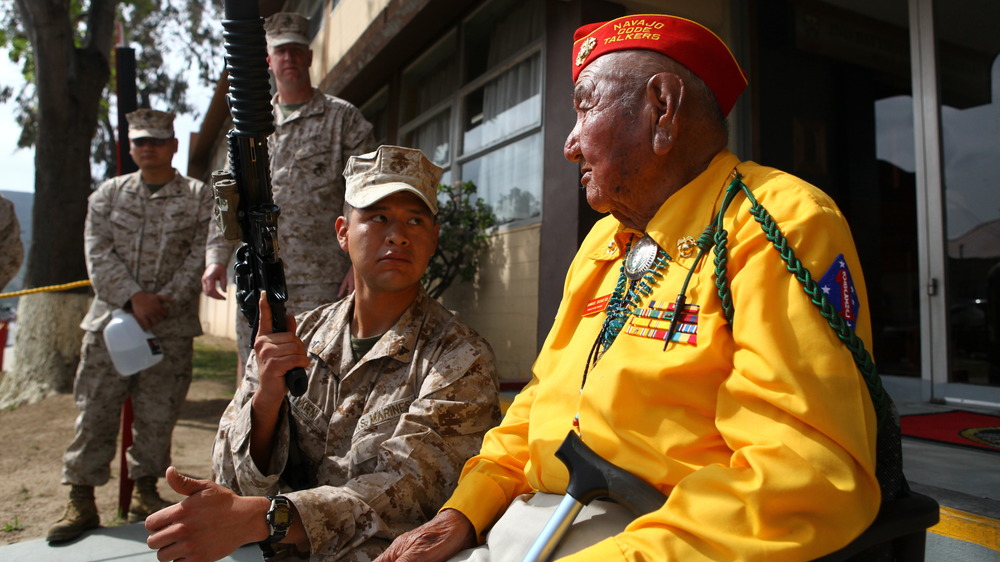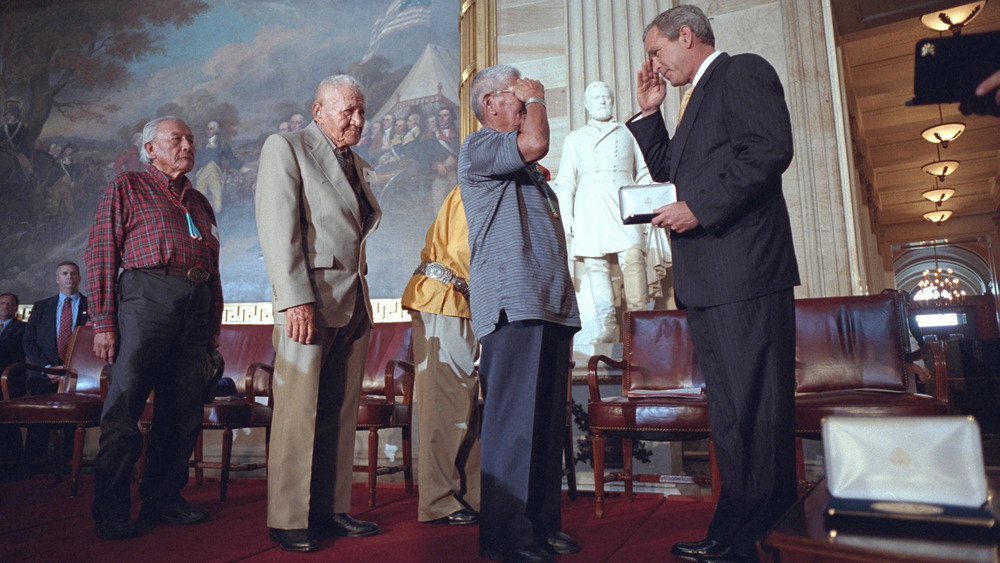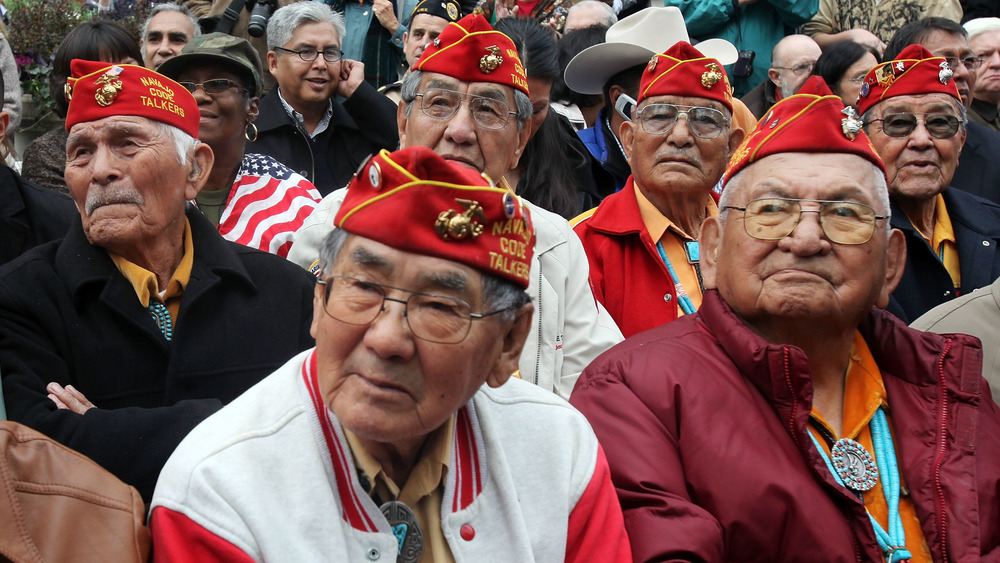The True Story Of World War II's Code Talkers
You don't have to read Sun Tzu to understand that the art of winning a war is usually a bit more complicated than who has the biggest, nastiest, ugliest weapons. Belief systems can help or hinder a war effort. Cultural values come into play. Clever logistics, inspired leadership, and advanced scientific brainology don't hurt either. Then there's the Royale with Cheese — the single critical variable upon which the fortunes of entire armies, and even nations, have turned — information.
Hiding what you know (and uncovering what your enemy knows) has always been a part of human conflict. And where information leads, spy craft, subterfuge, codes, and cryptography must surely follow. The true story of World War II's code talkers is a tale about information and war. It's the story of how a brutally complex and beautifully nuanced Native American language birthed an unbreakable code. It's also the story of roughly 500 courageously sneaky Navajo servicemen who would become known as the code talker.
The Choctaw Telephone Squad
Code talkers first found their way onto the pages of military history in the dark October of 1918, according to "Code Talker: United States History" on Britannica. It was in the last dying days of World War I. Allied troops were being deployed to reclaim a German-held position — a brutal campaign known as the Meuse-Argonne offensive. Communication technology was still in its infancy, and open radio frequencies and telephone lines were routinely used to convey vital military intelligence.
As it just so happened, eight American Indian soldiers of the Choctaw tribe served as telephone operators during the offensive. The Choctaw Telephone Squad, as they'd later be known, realized they were sitting on a coded communication gold mine. It was vanishingly unlikely that anyone else spoke Choctaw anywhere in Europe. The subtle complexity of the language and its unusual phonetic structure made Choctaw all but impenetrable to sneaky cryptographic reverse engineering. All it took for the squad to swiftly and securely share military intel was to speak in their mother tongue. It was a perfect code, ready baked for military consumption. In the last days of World War I, Allied Forces had found a near-perfect way to swiftly transfer critically sensitive data. It was an idea just waiting to be modified to work on a larger scale. And unfortunately, the opportunity to do precisely that lay just around the historical corner.
The genesis of the code talker
Flip the page forward three decades, and another brutal world war was raging. United States forces faced an intelligence crisis in the Pacific theater. Japanese cryptographers were cracking codes faster than Allied intelligence could devise them. Leveraging sophisticated computational expertise alongside their deep fluency with standard and colloquial U.S. English, Japanese code breakers could decode a message in hours. Allies had no defense. "Military communications were made available to the enemy like sand sifting through a sieve," HistoryNet reports. Allies had to find a better way to encode their messages —and fast.
Philip Johnston was a retired U.S. serviceman who had grown up a missionary kid on a remote Navajo station. He knew the challenges. He understood the intricacies of the language. He was familiar with how successfully the Choctaw Telephone Squad had bamboozled the enemy. Johnston connected the dots and pitched his idea to the right people. Just a few months later in 1942, marine personnel had recruited 29 Navajo volunteers. They were rushed through basic training at the Recruit Depot in San Diego and were given intensive military communications training. After their brutally rushed 101 on the subtle Devil's Macarena of warfare and code craft, the Navajo recruits were given a top-secret task — to devise an unbreakable code.
No pressure or anything
Bear in mind, cryptography had advanced in leaps and bounds since the early years of the 20th century. Military intelligence knew that merely speaking in an unusual and seldom spoken language wouldn't cut it — not by itself. The Allies needed a new kind of code. It had to be intuitive enough to the Navajo that it would feel as effortless as speaking their own language. The code also had to be efficient, allowing soldiers to communicate swiftly about military activity in the thick of battle. And it needed to be done yesterday. Lives depended on it. "This major took us into a great big room and he said, 'you guys are going to have to make up a code in your own native language,' that's all he said. He left, closed the door behind him and locked the door. We didn't know what to think," recalls Chester Nez, one of the founding code talkers, for the National Museum of the American Indian at the Smithsonian.
Their approach had two phases, according to Codemakers: History of the Navajo Code Talkers. The first iteration simply assigned Navajo words to English letters. A series of Navajo words represented each letter of the alphabet. For example, the Navajo use the word for "ant," wo-la-chee, to represent the letter A. By mapping several words to each letter, the code acquired randomness. The second phase became more sophisticated, using whole words directly translated into Navajo and a small vocabulary of dedicated military words. A dictionary of over 400 military terms was added to the code to ensure that data could be passed quickly and accurately. The first code talkers found the seed of this idea in just a few hours. The code would never be cracked.
The perilous life of a code talker
The typical image of a military cryptography expert places them safely in a bunker somewhere. This wasn't the life these Navajo servicemen experienced. According to an account described in Unsung Heroes of World War II, code talkers operated in the heart of combat. Working in pairs, code talkers would set up communication centers in the field, assembling radio stations, laying wire out to outposts, and often accompanying soldiers on combat patrols with portable radios. With minimal training, code talkers would even be sent out behind enemy lines to report on troop movements, military capability, and even the location of sniper activity. Adding to their daily dose of mortal peril, enemy soldiers soon recognized the strategic significance these heavily equipment-laden communication officers possessed. Code talkers were frequently singled out by sharpshooting enemy soldiers.
But death or injury from the other side was only part of the hardship code talkers faced. In Codemakers: History of the Navajo Code Talkers, one code talker describes his experience at a food line at camp. "All of a sudden I heard somebody say ... 'Halt, or I'm gonna shoot!' ... There was a big rifle all cocked and ready to shoot." The Navajo were routinely mistaken for Japanese soldiers. Racial discrimination, whether accidental or incidental, would become a familiar experience for these officers. It made their role even more complex and perilous.
Trial by fire: The Iwo Jima Campaign
By the time the war in the Pacific had reached its peak, the code talkers had become vital to the war effort. All other methods of cryptography had failed, while the linguistic complexity of coded Navajo stayed as untouchable as the first day it was used. Coupled with its nimbleness and versatility, the code of the Navajo code talkers had become a key ingredient in shifting the tide of war. This was especially significant for one of the largest and most brutal campaigns in the Pacific — the battle for Iwo Jima.
By now, code talkers were a familiar sight. Out in the field, snipers were ordered to target radiomen, officers, and medics as a first priority. This meant that the code talkers had to keep moving as they transmitted their messages. It was a deadly juggling act of lugging heavy equipment, dodging enemy fire, and accurately relaying vital military information in code on the fly. The entire Allied operation in this campaign was coordinated using the Navajo Code. According to 1942: Navajo Code Talkers on the U.S. Intelligence Community website, by the end of the campaign, code talkers sent and received over 800 messages in the heat of battle — all without error. A Marine signal officer who fought in the campaign said, "were it not for the Navajo code talkers, the Marines never would have taken Iwo Jima," HistoryNet reports.
Why was the approach so effective?
The Navajo Code was unparalleled in its ability to quickly deliver coded messages. For all the complexity of standard coded messages, Axis Power cryptographers could break these codes in hours. The science of coding and decoding had come forward in leaps and bounds, just as other technologies like rocketry, aerial warfare, and military tactics had fundamentally transformed. So, what made the Navajo code different? What made it better?
Much of the answer gets back to some unique defining features of the Navajo language itself. Like very nearly all languages spoken by Native American people, Navajo lacks anything resembling an alphabet. The language was therefore naturally resistant to being printed, which immediately hamstrung efforts to dissect and unravel it, Britannica reports. Moreover, few scholars of the 1940s or prior had paid more than passing scholastic attention to Navajo. A researching cryptographer couldn't start with a linguistic textbook on Navajo, because no such book existed.
San José University's Navajo Code Talker Page explains that Navajo is also a tonal language. The same spoken word can radically change in meaning depending on whether it's spoken in a low, high, rising, or falling tone of voice. Someone not deeply acquainted with the language would likely completely miss these sound nuances. But it gets even harder. The linguistic structure of Navajo bears no resemblance to any European language. Even if a listener could somehow discern individual words within a sentence, they'd still find themselves dealing with a syntax completely unlike their own. Navajo was a perfect foundation for a code because it was complex, unusual, and unique.
Extra layers of sneakiness
A seemingly impenetrable language wouldn't be much use as a military code if it couldn't efficiently and reliably transmit information. This is where the system developed by the code talker code is perhaps most surprising. With no prior cryptography training the Navajo code talkers somehow managed to develop a system that was startlingly efficient as it was secure. Every critical feature a code talker needed to remember about the Navajo coding system could be distilled to 17 pages, according to Remembering the Navajo Code Talkers. The code talkers could memorize how to parse this code. No encoding machines were necessary. All the unwieldy technological and linguistic trappings of conventional military cryptography could be thrown out the window.
What was left was a lean, portable, and thoroughly adaptable way to communicate vital military intelligence. To send out just one message, an accomplished conventional coder would need several minutes to calibrate their coding machine and additional time to enter their data. A Navajo code talker could transmit the same message in seconds. And because their approach was fast and efficient, it was much easier for coded messages to be sent accurately under intense combat conditions.
Optimism after the war
By 1945, over 500 Navajo servicemen had joined the Marines. Over 400 of these had served as code talkers. The life of most of these people would never go back to what it was. "When I climbed aboard the transport ship that would take me to San Francisco, everything had changed," recalled decorated Navajo Code Talker Chester Nez in his memoir Code Talker. Many of the 421 code talkers continued to serve in combat units overseas after Japan surrendered, according to Codemakers: History of the Navajo Code Talkers.
Some volunteered to remain in Japan, assisting in the occupation and rehabilitation of the Japanese state right through to the early 1950s. Others were sent to Marine units in China. Even though the unique wartime conditions that made Navajo code talking so powerfully effective had passed, the skillset remained an important (and top secret) military asset for years to come.
Many of the Navajo who opted to leave the military returned to a traditional way of life. They came home to family reunions and purification rituals, traditional dances, and prayers of thanks for a safe return. Interestingly, despite the many perils they faced during the war, few code talkers displayed evidence of serious psychological fatigue, HistoryNet reports. Nevertheless, some Navajo veteran accounts speak of feeling a permanent disconnect with their traditional way of life.
But it was still a hard life
Meanwhile, the United States had become a more complicated place, culturally. Navajo veterans occupied a strange corner of U.S. society in the wake of World War II. One the one hand, these fearless communications specialists with their uncrackable code had gained the respect and admiration of their comrades in arms — many of whom were struggling to find their own way back into civilian society. On the other hand, prejudice against Native Americans continued on much as it had before the war, but this time with new stakes and an added sting.
Jobs on reservations were hard to come by. In the remoter areas they were nonexistent. The G.I. Bill should have given Navajo veterans access to favorable loans. The U.S. government passed this bill precisely for that purpose — to help veterans build homes or gain some economic foothold in their return to civilian life. But many banks refused Navajo loan requests, according to Codemakers: History of the Navajo Code Talkers. Navajo families held reservation land parcels in trust, but they had no proof of title. It was a case of no title, no loan. Life after the war was tough for many code talkers. It'd be decades before society at large began to recognize their contribution.
The long-kept secret
Whether they left the military immediately after Japan surrendered or if they stayed in active service right through to the 60s, military intelligence officials unfailingly issued retiring Navajo code talkers the same warning — don't tell anyone. Their work and methods stayed top secret for decades after World War II. The Navajo were instructed to remain tight-lipped and secretive about their work. They couldn't tell their families, their friends, or even speak freely with other veterans. What they did, where they were deployed, and just how significant a role they played throughout the war were strictly off-limits.
When it came to fame and recognition, for years the code talkers were a victim of their own success, the New Orleans WWII Museum reports in "American Indian Code Talkers." Despite the best efforts of teams of talented cryptographers working against them, the Navajo language was simply too steep a wall to climb. Couple that complexity with a code that was blisteringly fast to transmit and seemingly perfect for battle conditions, and the U.S. simply couldn't afford to allow tales of the code talkers' exploits to see the light of day. The advent of modern cryptography and advanced computing eventually rendered the code obsolete, and the program was finally declassified in 1968. But it was an acknowledgment that came way too late for many Navajo servicemen.
Much-deserved recognition
But recognition did come — eventually. In 1982, President Ronald Reagan declared August 14 National Code Talker Day. In 2000, that recognition was enshrined in law with the Honoring Navajo Code Talkers Act, reports Indigenous affairs journalist, Shondiin Silversmith, for AZCentral.
In 2001, the Navajo code talkers were awarded Congressional Gold and Silver medals, over 50 years after coded Navajo messages first turned the tide of war in the Pacific. According to The White House archives, in his remarks, former President George W. Bush said, "The gentlemen with us ... are the last of the original Navajo Code Talkers. In presenting gold medals to each of them, the Congress recognizes their individual service, bravely offered and flawlessly performed. ... Your service inspires the respect and admiration of all Americans, and our gratitude is expressed for all time, in the medals it is now my honor to present." Five of the original code talkers were alive to receive the honor.
What about the language?
The recognition and the honors were a long time coming for the Navajo who served as code talkers. But there's still an unsung hero in all this. What about the Navajo language itself? According to U.S. census statistics, around 180,000 Navajo speakers were scattered around the U.S. in 2000. By 2010, U.S. Census Bureau data places that number at just over 166,000. Perhaps a more telling indicator though is whether Navajo is still being spoken as a natural part of daily life. Close to 90% of Native American families now only speak English at home, Census Bureau data indicates. Judged purely from the numbers, it looks as though this unique and wonderfully complex language is gradually fading away.
"The Navajo language is dying," writes the non-profit organization Navajo Language Renaissance. "The language of the Navajo Code Talkers, the language that saved thousands of lives in the Pacific Theater of WWII, is in danger of becoming extinct. ... Children of parents who speak Navajo cannot converse with their grandparents." But Navajo is not going gentle into that good night. Organizations like Navajo Language Renaissance are finding new ways to teach the language online. With enough coffee, patience, and bravery, a student can still grab a workbook and get to work. The language of the code talker may still live on.
